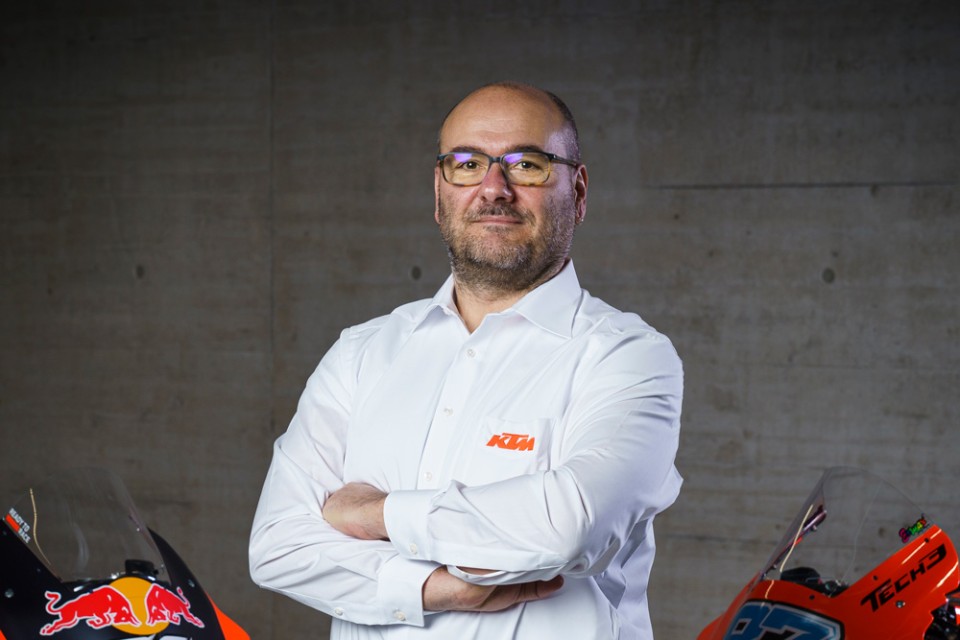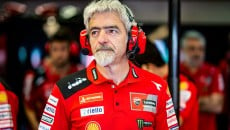While for the riders 2027 might be a distant date, which is almost difficult to think about, for engineers it is on the contrary very close. This is the year of the new MotoGP bikes, and they must already start thinking about them and designing them. About the new regulations we had already spoken with Paolo Bonora of Aprilia and Gigi Dall'Igna of Ducati, now it is the turn of Fabio Sterlacchini, Technical Director of KTM.
"Precisely because it is a compromise, you cannot give 10 to the new rule, but for me the mark is between 8 and 9 because there are a number of aspects that had to and have been taken into consideration - was his initial thought - First and foremost a reduction of the drift that there was in the increase in top speed. As it is not possible, in a reasonable period of time, to adapt the circuits, it is right to do it with the means: downsizing has its first reason for being in the fact that we had to reduce the power. Then there was also a 'philosophical' reason because it had been so many years since a real change, now and then these reshuffles, we've also seen it with the 800 and Formula 1, have their place."
Are there other aspects to consider as well?
"Yes, such as those of sustainability and safety that are secondary to the reduction in engine size. Also, because there will be lower power and therefore lower speeds, there will also be a need for less extreme aerodynamics. This, at least in theory, should reduce the difference in how the bike operates from when it is in slipstream to when it is not, and means making what happens in the overtaking maneuver more predictable. Nowadays, you get 'sucked in' by those in front of you - actually you reduce the aerodynamic drag - and when you come out of the slipstream you get held up and many times, trying to overtake in the slipstream, you risk contact and all these things."
Was removing the lowering devices right?
"We discussed in meetings whether it was right or not, or whether it was better to keep them just for overtaking, as is done in F1 with DRS. Perhaps, for the spectacle it would have made sense, but it would have meant keeping an on-board device that involves costs, issues and additional weight just for overtaking. Thinking about the costs and benefits, it was probably right. I also think that with these devices in recent years, the starts have become more uniform: they all get to the first corner faster and the same way. Without the lowering devices, the bike will tend to wheelie, you can change direction more easily, thinking about the show and safety it was more right to remove them."
Do you think a little more could have been done in terms of innovation?
"The time horizon is actually not that far away. There were discussions about hybrid systems, but you also have to keep a balance with the costs and system complexities, technologically you also need some follow-through in production that is not there at the moment. In Formula 1 they had to create departments that deal with the hybrid units, the power units, so I think it is right from the championship point of view. But you also have to have a broader vision."
Which one?
"On cars the hybrid makes a lot of sense because you can do energy recovery on the front wheels, where there is a lot of load, plus mass is really important, so is kinetic energy. In motorcycles, the hybrid is not there because it makes little sense technically: you have to meet regulations for both engines, plus there are space issues. We think the future of motorcycling is electric motorization for urban commuters or non-fossil fuels. It makes much more sense to have 'carbon neutrality' rather than going out and mining cobalt and lithium for batteries, complicating the design and increasing costs."
MotoGP already uses 40 percent non-fossil fuels, will it be a problem to get to 100?
"In the last 5 years there has been a technology surge with what you can do with synthetic fuels, which basically can be of two families. The first is the one where you turn plant organic matter into alcohol, which is then refined. In the second, however, with electricity obtained from renewable sources, you 'capture' carbon from the atmosphere and hydrogen from water, combine them, and create synthetic gasoline. I am surprised at the little difference with fossil fuels, at 40 percent you can hardly feel it and I am convinced that by the time we get to 100 percent, it will be the same.There are problems of a different nature than performance problems, because in these fuels they use a certain amount of ethyl alcohols that are more aggressive than conventional gasoline on certain components such as, trivially, injectors and seals."
The new regulation provides for the sharing of GPS data, is it that important?
"Yes and no. By now all the teams have cameramen on the track, and the MotoGP bikes already have GPS, even if it is not available to us. So we all asked, including ourselves, why do we have to keep spying on each other when there is GPS?(laughs). In Formula 1 it is already done. In my opinion it will be a technological challenge, because it's not so trivial either to run a GPS on a motorcycle or to read that data."
How good is it as an engineer to start from a blank sheet of paper?
"It's definitely challenging because you can treasure all the current basic parameters, but the design is radically revised. For example, if you have a bike with lots of power, like with the 1000 cc engines, the wheelie phase is important for performance, if you lower 40 or 50 hp the power becomes less important and you have to rebalance the bike. You can't just apply the new engine to the previous design."
Where do you start?
"You read the regulations and make a list of the main points of the project: how much power you expect, what configurations can be used. Normally you start by defining the engine because then the bike is built around that, depending on the power the design has to adjust. You can also take 2 or 3 different paths to explore, as done in the past with the screamer and the big bang."
Is there time to work calmly?
"We are OK. Also because we are not considering that there might be a change as far as tires are concerned. Apart from the expiry of Michelin's contract, which has the desire to stay anyway, there has been talk of changing the front tire type. If it happens, it would not be trivial, I remember the problems from going from 16.5 to 17 inches. In my opinion it will take all of 2026 to test either the new bike or the new bike and tires."
Will there be a problem with resources, both human and financial, to continue developing the current MotoGP bikes while designing the new ones?
"Ducati has raised this issue and proposed to freeze engine development in 2026 .It seems to us to be a correct idea and we espoused it. It would be wise, because engineers have to self-regulate, otherwise it's a constant struggle (laughs). It would give us a chance to limit resources and focus more on the new project. We just had concerns about possible reliability issues, but we were able to come to an agreement there as well."









